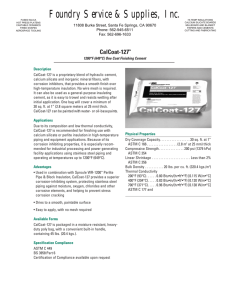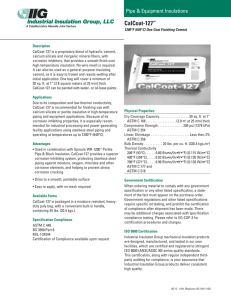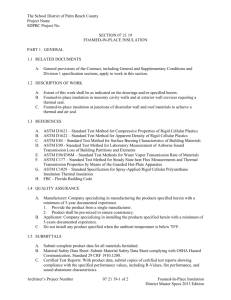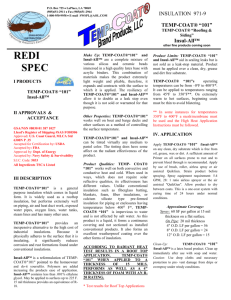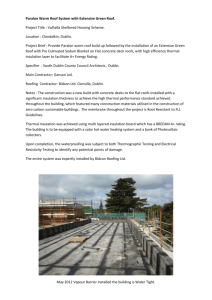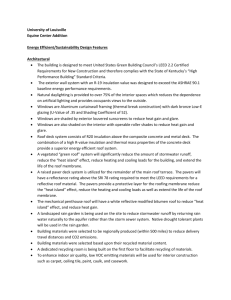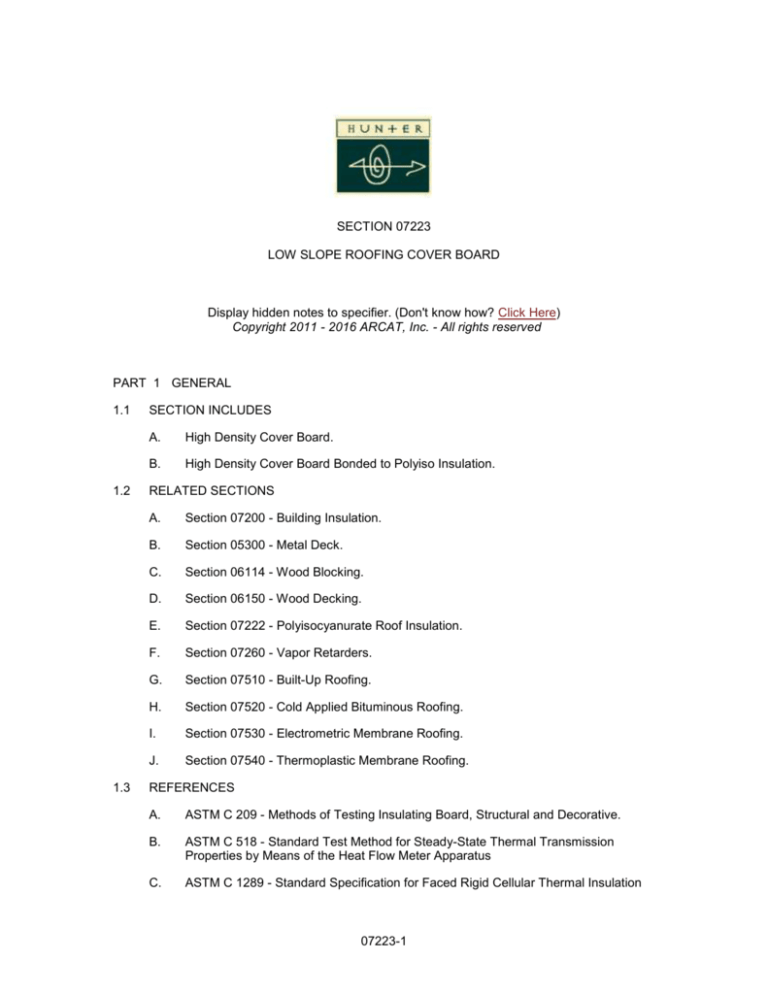
SECTION 07223
LOW SLOPE ROOFING COVER BOARD
Display hidden notes to specifier. (Don't know how? Click Here)
Copyright 2011 - 2016 ARCAT, Inc. - All rights reserved
PART 1 GENERAL
1.1
1.2
1.3
SECTION INCLUDES
A.
High Density Cover Board.
B.
High Density Cover Board Bonded to Polyiso Insulation.
RELATED SECTIONS
A.
Section 07200 - Building Insulation.
B.
Section 05300 - Metal Deck.
C.
Section 06114 - Wood Blocking.
D.
Section 06150 - Wood Decking.
E.
Section 07222 - Polyisocyanurate Roof Insulation.
F.
Section 07260 - Vapor Retarders.
G.
Section 07510 - Built-Up Roofing.
H.
Section 07520 - Cold Applied Bituminous Roofing.
I.
Section 07530 - Electrometric Membrane Roofing.
J.
Section 07540 - Thermoplastic Membrane Roofing.
REFERENCES
A.
ASTM C 209 - Methods of Testing Insulating Board, Structural and Decorative.
B.
ASTM C 518 - Standard Test Method for Steady-State Thermal Transmission
Properties by Means of the Heat Flow Meter Apparatus
C.
ASTM C 1289 - Standard Specification for Faced Rigid Cellular Thermal Insulation
07223-1
Board.
1.4
D.
ASTM D 312 - Standard Specification for Asphalt Used in Roofing.
E.
ASTM D 1621 - Test Methods for Compressive Properties of Rigid Cellular Plastics.
F.
ASTM D 2126 - Test Method for Response of Rigid Cellular Plastics to Thermal and
Humid Aging.
G.
ASTM D 3273 - Standard Test Method for Resistance to Growth of Mold on the
Surface of Interior Coatings in an Environmental Chamber
H.
ASTM E 84 - Surface Burning Characteristics of Building Materials.
I.
ASTM E 96 - Test Method for Water Vapor Transmission of Materials.
J.
ASTM E 108 - Standard Tests Method for Fire Tests of Roof Coverings.
K.
ASTM E 119 - Standard Test Methods For Fire Tests Of Building Construction and
Materials.
L.
FM Approval Guide - FM 4450 Approval Standard - Class I Insulated Steel Roof
Decks.
M.
FM Approval Guide - FM 4470 Approval Standard - Class I Roof Covering.
N.
UL 263 - Fire Tests of Building Construction and Materials.
O.
UL 790 - Tests for Fire Resistance of Roof Covering Materials.
P.
UL 1256 - Fire Test of Roof Deck Constructions.
SUBMITTALS
A.
Submit under provisions of Section 01300.
B.
Product Data: Manufacturer's data sheets on each product to be used, including:
1.
Preparation instructions and recommendations.
2.
Storage and handling requirements and recommendations.
3.
Installation methods.
C.
Shop Drawings: Roof plan layout of boards and fastening patterns.
D.
LEED Submittals: Provide documentation of how the requirements of Credit will be
met:
1.
List of proposed materials with recycled content. Indicate post-consumer
recycled content and pre-consumer recycled content for each product having
recycled content.
2.
Product data and certification letter indicating percentages by weight of
post-consumer and pre-consumer recycled content for products having
recycled content.
3.
List of proposed materials demonstrating that each material was extracted,
harvested or recovered, as well as manufactured within 500 miles of the
project site.
E.
Verification Samples: For each finish product specified, two samples, representing
actual product.
1.
Submit 6 by 6 inch (152 mm by 152 mm) samples of each board type
07223-2
2.
F.
1.5
1.7
1.8
Manufacturer's Certificates: Manufacturer's certification that materials meet or
exceed specification requirements.
QUALITY ASSURANCE
A.
1.6
required.
Submit samples of each fastener type required.
Manufacturer Qualifications: Manufacturer shall be a company that regularly
manufactures and assembles polyisocyanurate insulation panels in house with no
outside fabrication operations.
DELIVERY, STORAGE, AND HANDLING
A.
Store products in accordance with the manufacturer recommendations.
B.
Store product on a solid flat foundation and elevate a minimum of 4 inches above
the finished surface.
C.
For on-site storage longer than two weeks, slit packaging on 4 sides to allow the
product to breathe, and then completely covered with a breathable tarpaulin.
D.
Protect insulation from open flame and keep dry at all times.
PROJECT CONDITIONS
A.
Maintain environmental conditions (temperature, humidity, and ventilation) within
limits recommended by manufacturer for optimum results. Do not install products
under environmental conditions outside manufacturer's absolute limits.
B.
Do not apply cover board insulation or roofing materials when substrate is damp or
wet or when proper adhesive temperature cannot be maintained.
COORDINATION
A.
Coordinate work with installation of insulation, roof covering and associated roof
penetrations installed by other sections as work of this section proceeds.
PART 2 PRODUCTS
2.1
2.2
MANUFACTURERS
A.
Acceptable Manufacturer: Hunter Panels, which is located at: 15 Franklin Street;
Portland, ME 04101; Toll Free Tel: 888-746-1114; Tel: 207-761-5678; Fax:
877-775-1769; Email: request info (info@hpanels.com); Web:
www.hunterpanels.com | www.hunterxci.com
B.
Substitutions: Not permitted.
C.
Requests for substitutions will be considered in accordance with provisions of
Section 01600.
MATERIALS
A.
High Density Cover Board: Flat H-Shield HD; high density polyiso insulation panel
with premium performance coated glass facers specifically designed for use as a
cover board.
1.
Properties:
07223-3
a.
b.
2.
3.
4.
5.
6.
7.
B.
Compressive Strength: ASTM D 1621, > 100 psi.
Dimensional Stability: ASTM D 2126, < 0.5 percent linear change in 7
days.
c.
Water Absorption: ASTM C 209, < 1 percent volume.
d.
Resistance to Mold: ASTM D 3273, Passed (10).
e.
Service Temperature: 260 degrees F or less.
f.
Recycled Content: > 8 percent.
Weight: 0.3431 lbs/sq ft
Panel Size: 48 inches by 96 inches (1219 mm by 2438 mm).
Thickness: 0.50 inch (12.5 mm),
R Value: R Value 2.5 as tested in accordance with ASTM C 518.
Hail Rating: SH-1.
Codes and Compliances:
a.
UL Classified 790.
b.
ASTM E 108.
c.
FM Approved.
High Density Cover Board Bonded to Flat Foam Insulation: Flat H-Shield HD
Composite CG; H-Shield CG rigid polyiso roof insulation foamed on line to high
density polyiso insulation cover board and conforming to ASTM C 1289, Type IV
with square edges.
1.
Grade:
a.
Grade 2. Compressive Strength: 20 pounds per square inch (138 kPa).
b.
Grade 3. Compressive Strength: 25 pounds per square inch (172 kPa).
2.
Properties:
a.
Compressive Strength: ASTM D 1621, > 100 psi.
b.
Dimensional Stability: ASTM D 2126, < 0.5 percent linear change in 7
days.
c.
Water Absorption: ASTM C 209, < 1 percent volume.
d.
Resistance to Mold: ASTM D 3273, Passed (10).
e.
Service Temperature: 260 degrees F or less.
f.
Recycled Content: > 8 percent.
3.
Flat Foam H-Shield CG Insulation Properties:
a.
Compressive Strength: ASTM D 1621/ASTM C 1289, > 20 psi (Grade
2), 25 psi (Grade 3).
b.
Dimensional Stability: ASTM D 2126, < 2.0 percent linear change in 7
days.
c.
Moisture Vapor Transmission: ASTM E 96, < 1 perm.
d.
Water Absorption: ASTM C 209, < 1 percent volume.
e.
Service Temperature: minus 100 to 250 degrees F (minus 73 degrees
C to 122 degrees C).
4.
Panel Size:
a.
47.5 inches by 47.5 inches (1207 mm by 1207 mm).
b.
47.5 inches by 95.5 inches (1207 mm by 2426 mm).
5.
Hail Rating: SH-1.
6.
Fire Ratings:
a.
UL 1256, No. 120 and 123.
b.
UL 790 (ASTM E 108), Class A.
c.
UL 263 (ASTM E 119).
d.
FM 4450/4470, Class1 Fire Rating.
7.
R Value: Provide Insulation with LTTR (Long Term Thermal Resistance) in
accordance with ASTM C 1289. Minimum thickness of panels shall be as
follows:
a.
Thickness 2.00 inch (51 mm), R Value 11.1, flute spanability 4-3/8
inches (111.13 mm).
b.
Thickness 2.25 inch (57 mm), R Value 12.5, flute spanability 4-3/8
07223-4
c.
d.
e.
f.
g.
h.
i.
2.3
inches (111.13 mm).
Thickness 2.50 inch (64 mm), R Value 13.9, flute spanability 4-3/8
inches (111.13 mm).
Thickness 2.75 inch (70 mm), R Value 15.4, flute spanability 4-3/8
inches (111.13 mm).
Thickness 3.00 inch (76 mm), R Value 16.9, flute spanability 4-3/8
inches (111.13 mm).
Thickness 3.25 inch (83 mm), R Value 18.4, flute spanability 4-3/8
inches (111.13 mm).
Thickness 3.50 inch (89 mm), R Value 19.9, flute spanability 4-3/8
inches (111.13 mm).
Thickness 3.75 inch (95 mm), R Value 21.4, flute spanability 4-3/8
inches (111.13 mm).
Thickness 4.00 inch (102 mm), R Value 23.0, flute spanability 4-3/8
inches (111.13 mm).
ACCESSORlES
A.
Approved Fasteners: Appropriate for purpose intended and approved by FM
Approvals and system manufacturer; length required for thickness of insulation
material and penetration of deck substrate, with distribution plates if required.
B.
Base Ply: As recommended by membrane manufacturer.
C.
Asphalt Bitumen: ASTM D 312, Type III, or Type IV.
1.
Use only on approved board insulation types.
2.
Provide with labels indicating flash point, softening point, finished blowing
temperature and equiviscous temperature.
PART 3 EXECUTION
3.2
3.3
A.
Do not begin installation until substrates have been properly prepared.
B.
Examine roof deck for suitability to receive cover board. Verify that substrate is dry,
clean, and free of foreign material that will damage installation.
C.
Verify that roof drains, scuppers, roof curbs, nailers, equipment supports, vents, and
other roof accessories are secured properly and installed in conformance with
drawings and submittals.
D.
Verify that deck is structurally sound to support installers, materials, and equipment
without damaging or deforming work.
E.
If substrate preparation is the responsibility of another installer, notify Architect of
unsatisfactory preparation before proceeding.
PREPARATION
A.
Clean surfaces thoroughly prior to installation.
B.
Prepare surfaces using the methods recommended by the manufacturer for
achieving the best result for the substrate under the project conditions.
C.
Apply vapor barrier and or retarder, as specified by the Architect or required by the
local building code, to decking prior to installation of insulation.
INSTALLATION
07223-5
A.
Install specified cover board in accordance with manufacturer's latest printed
instructions and as required by governing codes and Owner's insurance carrier.
B.
Do not leave installed cover board exposed to weather. Cover and waterproof
immediately after installation.
C.
Seal exposed joints at the end of each day. Remove seal when work resumes.
D.
Remove installed cover board that has become wet or damaged and replace with
new solid and dry material.
E.
Built-Up, Coal Tar and Modified Bitumen Systems:
1.
Secure each cover board panel to the roof deck with Factory Mutual approved
fasteners and plates (appropriate to the deck type).
2.
Adhere maximum 4 foot by 4 foot (1220 mm by 1220 mm) panels of cover
board to a prepared concrete deck with a full mopping of hot steep asphalt.
3.
Adhere maximum 4 foot by 4 foot (1220 mm by 1220 mm) panels of cover
board to a prepared concrete deck with FM approved cold adhesive.
4.
Butt edges and stagger joints of adjacent panels.
5.
Roof Insulation: Install subsequent layers of roof insulation as specified in
Section 07222.
F.
Single-Ply Systems Ballasted Single-Ply Systems:
1.
Each cover board panel is loosely laid on the roof deck.
2.
Butt edges and stagger joints of adjacent panels.
3.
Roof Insulation: Install subsequent layers of roof insulation as specified in
Section 07222.
4.
Install the roof covering according to the roof manufacturer's specifications.
G.
Mechanically Attached Single-Ply Systems:
1.
Each cover board panel must be secured to the roof deck with Factory Mutual
approved fasteners and plates (appropriate to the deck type).
2.
Butt edges and stagger joints of adjacent panels.
3.
Roof Insulation: Install subsequent layers of roof insulation as specified in
Section 07222.
4.
Install the roof covering according to the roof manufacturer's specifications.
H.
Fully Adhered Single-Ply Systems:
1.
Secure each cover board panel to the roof deck with Factory Mutual approved
fasteners and plates (appropriate to the deck type).
2.
Adhere maximum 4 foot by 4 foot (1220 mm by 1220 mm) panels of cover
board to a prepared concrete deck with a full mopping of hot steep asphalt.
3.
Adhere maximum 4 foot by 4 foot (1220 mm by 1220 mm) panels of cover
board to a prepared concrete deck with cold adhesive.
4.
Butt edges and stagger joints of adjacent panels.
5.
Roof Insulation: Install subsequent layers of roof insulation as specified in
Section 07222.
6.
Install the roof covering according to the roof manufacturer's specifications.
I.
Re-roofing Single-Ply systems:
1.
Remove existing single ply membrane and clean surface of debris or
irregularities.
2.
Verify that the existing insulation is dry and sound.
3.
Install coverboard insulation in a single layer on top of intact and dry
insulation.
4.
Butt edges and stagger the joints in accordance with good roofing practice
and fasten as per manufacturer's specifications.
07223-6
5.
3.4
CLEANING
A.
3.5
Install the new Single-Ply membrane according to the roof manufacturer's
specifications.
Remove trash and construction debris from insulation before application of roofing
membrane.
PROTECTION
A.
Protect installed products until completion of project.
B.
Protect installed board traffic by use of protective covering materials during and after
installation.
C.
Cover the top and edges of unfinished roof panel work to protect it from the weather
and to prevent accumulation of water under the panels. Only apply enough cover
board per day that can be covered by the finished roof system.
D.
Do not leave panels exposed to moisture. Wet panels shall be removed or allowed
to completely dry prior to application of vapor barrier and/or roof covering.
E.
Repair or replace damaged products before Substantial Completion.
END OF SECTION
07223-7

